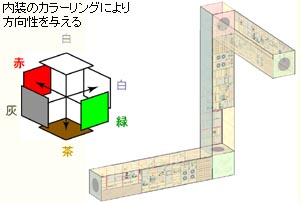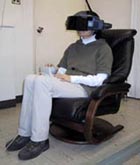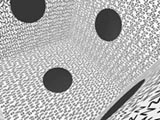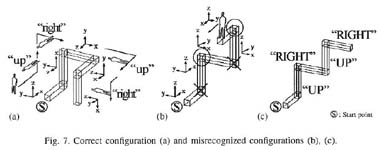|
 The effect of the configuration and the interior design of a virtual weightless space station on human spatial orientation
The effect of the configuration and the interior design of a virtual weightless space station on human spatial orientation
|
|
<Acta Astronautica, No. 56, pp. 1005-1016, 2005>
Hirofumi Aoki, Ryuzo Ohno, Takao Yamaguchi
|
| Full paper → PDF |
In a virtual weightless environment, subjects’ orientation skills
were studied to examine what kind of cognitive errors people make when
they moved through the interior space of virtual space stations and what
kind of visual information effectively decreases those errors. Subjects
wearing a head-mounted display moved from one end to the other end in space
station-like routes constructed of rectangular and cubical modules, and
did Pointing and Modeling tasks.
In Experiment 1, configurations of the routes were changed with such variables as
the number of bends, the number of embedding planes, and the number of planes with respect to the body posture.
The results indicated that spatial orientation ability was relevant to the variables and that orientation errors
were explained by two causes. One of these was that the place, the direction, and the sequence of turns were incorrect.
The other was that subjects did not recognize the rotation of the frame of reference, especially when they turned in
pitch direction rather than in yaw.
In Experiment 2, the effect of the interior design was examined by testing three design settings. Wall colors that showed the allocentric frame of reference and the different interior design of vertical and horizontal modules were effective; however, there was a limit to the effectiveness in complicated configurations. |
 |
 A Study of Orientation in a Zero Gravity Environment by means of Virtual Reality Simulation A Study of Orientation in a Zero Gravity Environment by means of Virtual Reality Simulation |
<Journal of Gravitational Physiology, Vol. 7, No. 2, pp. 93-94, 2000>
Hirofumi Aoki, Takao Yamaguchi, Ryuzo Ohno |
| This study intends to clarify how people acquire visual information and recognize their orientation in a zero gravity environment. An experiment was conducted using virtual reality.
In Study 1, each subject was given tasks in which a subject moves through virtual reality from the central room into one of six rooms such as operation room and habitation room. Textures composed by alphabetical letters were stuck on the six surrounding surfaces of the central cubic room. Visual information of the cubic room and the degree-of-freedom of motion were varied, and the subjects’ performance was measured. To some extent, the experiment produced a subjective sense of weightlessness. Moreover, we identified different strategies of spatial cognition and behavior under conditions of virtual weightlessness.
In Study 2, subjects’ orientation skills were tested with pointing and orienting tasks. Subjects followed virtual routes that were constructed of three or four rectangular modules that were connected by the cubical modules. Each subject moved from one end to the other end, and pointed to the start point and reproduced the experienced route using a scale model. The shapes of the routes were changed systematically.
Analyses of the results indicate that the ability of special cognition changes with such variables as the number of comers of routes, the geometric number of fields and the number of fields with consideration to the body posture.
|
  |
 |
| Full paper → PDF |
|
goto TOP
|
|
|
|